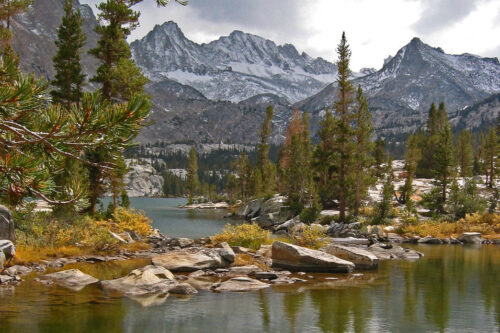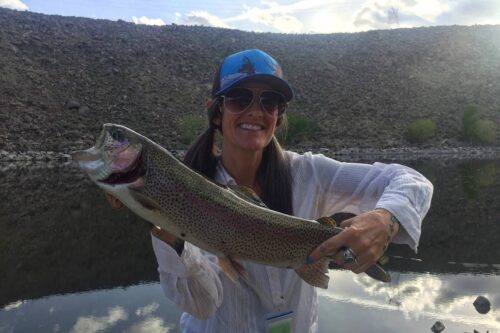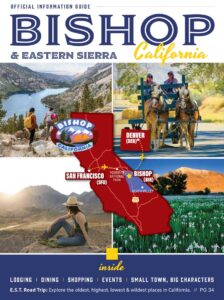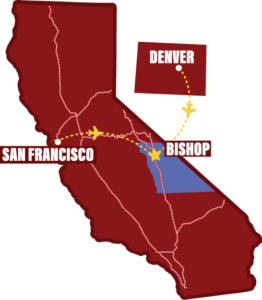Hiking with dogs in the Eastern Sierra
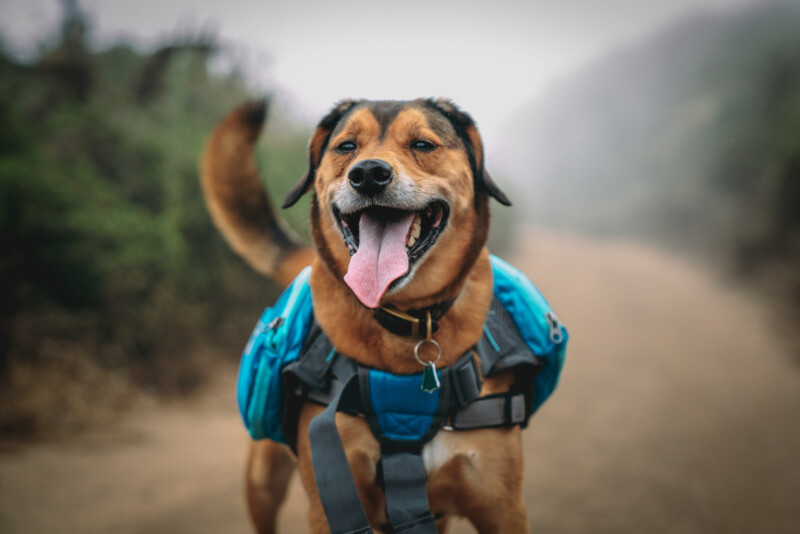
One of the best things about living in and visiting the eastern Sierra are the thousands of acres of public land available for recreating. These mountains, valleys, and tablelands allow us incredible freedom in the ways we can visit them, including bringing our dogs along. No matter whether the land is administered by USFS, BLM, or LADWP, chances are Fido is welcome. The odds are also good that there will be a water source or two along the hike, and often quite a lot of shade available for rest stops and lunch breaks. We explore these public lands with our dogs year round, choosing to drop lower in elevation during the winter months, and heading for the hills when it warms up.
Having a dog (or two) is almost a prerequisite for living in the mountains, and on any day you’ll find locals out running the trails, riding horses, or hiking with a dog. In addition to all the wonderful wild places, Bishop has a great dog park if your dog’s taste runs more to chasing frisbees or you just need to get him or her out during a busy day in town.
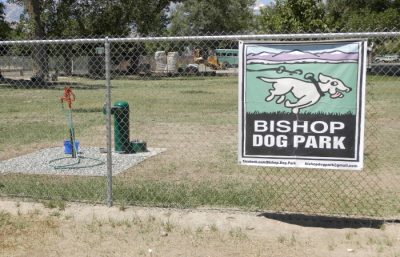
We’ve gathered together some best practices regarding hiking with dogs, some hazards to be aware of, and some resources in town to help outfit you and your dog for a safe and enjoyable hike. Most of us think nothing of loading our dogs up and simply heading out, but over the years we’ve learned a few tips we’d like to pass on.
The Elephant in the Room – to leash or not to leash
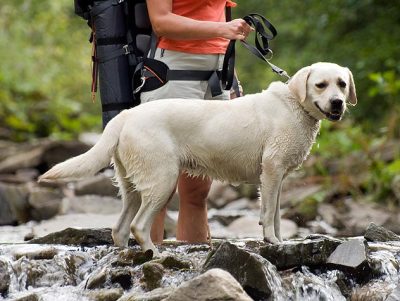
We know this can be a touchy topic but we recommend always carrying a leash when you hike with your dog, and even it may not be required and you may not use it; you’ll have it. We’ve used collars and leashes as impromptu slings to help an over-tired dog, relied on a good harness to allow a refreshing swim close to shore in bigger water than we were willing to risk if unleashed, and taken advantage of a free assist on the uphills with a big dog in a harness. Most experts suggest that you leash your dog with a 10′ or shorter nonretractable sturdy leash and a harness – much less pulling. We can think of any number of good reasons for leashing including the following:
- Safety of the dog
- Protection of wildlife
- Trail Etiquette
Safety of the Dog
The mountains and deserts are great places to explore, but it’s good to remember that they are wild places. We see our fair share of coyotes, bobcats, mountain lion, snakes, and even fawn-protecting deer around these parts; and keeping your dog on a leash means keeping your dog out of harm’s way. Even water can be a potential hazard, especially during spring melts when normally placid creeks turn into raging torrents. Play it safe with a leash and everyone enjoys the hike without worry.
Overheating can be a concern during the summer months. Dogs pant and sweat through their pads to cool off, and being much closer to the ground they are exposed to more radiant heat coming off a trail. A leash discourages long, cross-country running that can raise your pup’s body temperature even faster. We learned this the hard way with our large dogs on a summer day hike in the Sierra; they got too hot and we had to inch our way back home working from shady spot to shady spot.
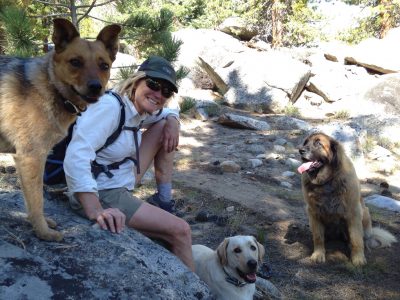
Toxic plants, thorns, and seeds like foxtail can cause problems long after the hike – leashing your dog helps minimize the exposure to these off-trail hazards. We know; we’ve watched in horror as our labrador lifts his leg and teeters next to a cholla cactus on one of our regular 395 stops… now we keep him on a leash during his road trip potty breaks. It doesn’t bother him in the least, and we spend much less time fretting.
Protection of Wildlife
Most dogs find chasing things almost irresistible and in the backcountry that instinct can lead to all sorts of mischief. From disturbing young wildlife to getting themselves hurt in the chase, it’s never a good idea to let dogs run after another animal. Plus, how are you going to get that once-in-a-lifetime photo if your dog mistakenly scares off the buck (or bighorn sheep or fawn)?
Wildlife can also turn on your dog, resulting in injury or illness. No one enjoys riding home with a dog that’s been “skunked”, or going through the stress of getting a dog with a snake bite to the vet on time. Leashes just give you such peace of mind, take up little space, and best of all – dogs get used to them pretty quickly!
Trail Etiquette
It can be hard to believe, but not everyone is a dog lover. And even if everyone you meet on the trail is, they may prefer that they meet your dog at the end of a leash. Keeping your dog under physical control can be very reassuring to other people on the trail and it demonstrates generosity and tolerance for non-dog folks. It can also really foster dog-friendly places, as people’s dog fears subside.
Riders (horse and bike) and hikers have the right of way on a trail. Unleashed dogs can be a nuisance or even cause accidents with equines and bikes- so always move off the trail with your leashed dog and let the animals and riders pass by. Many mules by nature are not fond of dogs, so you may also be keeping your dog safe from a well-aimed kick if you move off trail with your dog under control. Generally it’s best to move well uphill from the riders and stay in view; and a pleasant greeting will help the horses and mules realize you are just a friendly human and not a scary monster. It should go without saying that you should never let your dog run after a horse or a mule, after all you never know when someone might need a ride out!
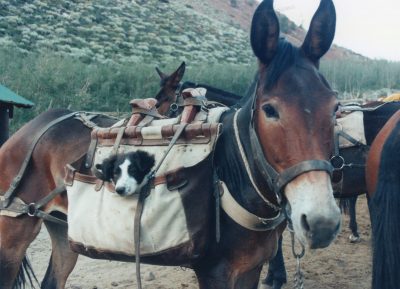
One of the big challenges in our well-loved backcountry is what to do with human and animal waste. We recommend that you carry bags for your dog’s waste and carry it out if you are on a day hike; if you double or triple bag it you can safely store it in a designated backpack pocket until you can dispose of it at a dumpster or trash can. If you are backpacking or prefer to bury it; use the same guidelines as for human waste, which is to bury it 6-8″ deep in a hole at least 200′ from trails, camps and water.
Equipment
You don’t need any special equipment to hike with your dog, aside from a leash, but there are many products available that help dogs do well on longer hikes, share the burden of carrying food and water, and address emergencies on the trail.
Dog Pack
Dog packs come in all sizes and allow your dog to carry some of the load on a long day hike or overnight trip. Many outdoor retailers carry dog packs, and most dogs quickly adapt to having the extra weight and girth (although we have seen our own dogs underestimate the space needed to sideswipe a tree from time to time). You’ll want to make sure you only have the dog carrying a maximum of 25% of it’s body weight, and even that will depend on the animal’s age and size.
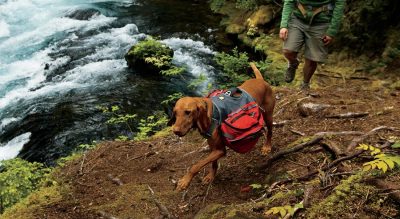
Collapsible Water/Food Bowl
Water is essential to a good hike and if your planned route doesn’t include a good, steady source of water, you’ll have to carry enough for your four-legged buddy. A collapsible water bowl makes it so easy to dole out that water without waste, dip a bowlful from a lake, or feed a little midday snack. Most come with a carabiner that clips on to the outside of your pack, keeping it handy.
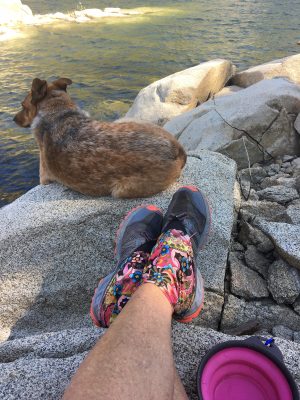
Booties
Booties aren’t something you’ll strap on for every day hike, but there are times when you may need them. Hiking over sharp, abrasive granite, over crusty spring snow, or very hot sand are a few conditions that can injure your dog’s pads. If you know you’re going to be spending time in such an area, or you are out for several long days of hiking, you may want to consider picking up a set of booties for your dog. It’s important to get your dog used to the booties well in advance of your trip or you may lose your investment the first time out.
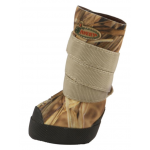
Specialty Collars / Harnesses
Harnesses can be a dog-owner’s best friend. Harnesses really discourage pulling, so they can make being leashed easier on the owner and the dog – the dog learns quickly that there’s little reward in pulling, so they tend to walk better beside you. Harnesses don’t put any pressure on the dog’s neck or trachea – no choking sounds while lunging at the end of your leash any more. Like booties, you’ll want to practice with the harness at home before the trip, but most dogs adapt really quickly to the putting on, wearing, and taking off of a harness.
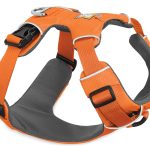
First Aid Kit
You probably already carry a basic first aid kit, but to make sure you have Fido covered, consider adding some old, clean wool socks to use as emergency booties (keep them on with duct tape over the sock and around the dog’s lower leg), kid’s benadryl, tweezers and maybe even needle-nose pliers in you are in cactus or porcupine country. Buffered aspirin is usually okay for pain in an emergency, but make sure you check with your vet for dosage and possible dog-friendly anti-inflammatory meds to carry instead.
Raingear, Personal Flotation Device, Sweaters, etc.
While our dogs don’t generally wear sweaters or raingear because they have a lot of hair, some breeds can really benefit from having an extra layer. Nights can be chilly even in the summer if you are camping in the Sierra.
We’re big fans of Personal Flotation Devices (which we’ve heard referred to as DFDs – dog flotation devices), even with dogs that are natural swimmers. There are a couple of reasons for this, including the fact that our high elevation lakes are COLD! Year round. We don’t use the PFDs for a quick swim during a hike, but if we are paddle boarding, kayaking, or boating our dogs proudly sport their PFDs.
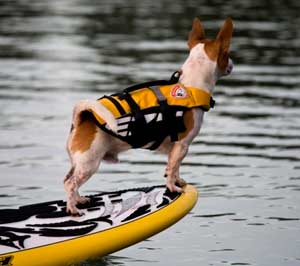
Favorite Trails
Where to start? We’ll quickly list a couple of our seasonal favorites, then link you over to some lists of trails that you might explore with your dog.
Summer
Tyee Lakes Trail: Start at Lake Sabrina in Bishop Creek Canyon – approx 5.5 miles out and back. Great early summer hike. https://www.alltrails.com/trail/us/california/tyee-lakes-trail
Discovery Trail: Just one mile, but you can spend hours here. Up in the White Mountains with views of the Sierra and the Ancient Bristlecone Forest. https://www.alltrails.com/trail/us/california/discovery-trail
Fall
McGee Creek Canyon: Spectacular fall color. Expect a good number of other hikers. An up-and-back hike as far as you want to go. https://www.hikingproject.com/trail/7024810/mcgee-pass-trail
Sabrina Basin Trail: Out and back is about 7.5 miles. You’ll share the trail with other dogs and possible horses. Go when the fall color hits Bishop Creek Canyon. https://www.alltrails.com/trail/us/california/sabrina-basin-trail-to-donkey-lake
Winter
Along the Lower Owens River: Drive out to the Lower Owens from Hwy 6 (5 Bridges Road) or from Pleasant Valley Dam and you’ll find some great winter walking along the dirt roads. Beautiful vistas, close to water, and plenty of room. Watch out for cars on the road. Well-loved by fishermen and women. For another idea, check out an Owens River Gorge hike as shot by Richard Kinney on YouTube: https://www.youtube.com/watch?v=T3oGEbtk6Ac
Tungsten Hills: Gigi de Jong put together a great blog post on winter/spring hikes, all of which are dog-friendly. Check out the Tungsten Hills hike here: https://bishopvisitor.com/4-super-spring-hikes-around-bishop/
Spring
Volcanic Tablelands: Once wildflowers begin to appear in the high desert, make a point of walking out on the Tablelands. While there aren’t any real marked trails to follow, it’s easy to create your own favorite walk out there. Share the trail with runners and hikers in the early season. https://bishopvisitor.com/volcanic-tableland-loop-trail-running/
Lower Rock Creek Canyon Trail: A local’s favorite, and well-used. Keep your eyes open for mountain bikers and other hikers. You can start at the top, off U.S. 395 just below Tom’s Place, or start from the bottom below Paradise. Parking is available on either end; just watch out for cars on the sometimes busy road. https://www.mtbproject.com/trail/4914078/lower-rock-creek-trail
https://www.alltrails.com/us/california/bishop/dogs
Local Resources
Veterinary Hospitals
Outdoor Retailers
Additional Resources
http://thebark.com/content/proper-trail-etiquette-hiking-your-dog
http://dogtime.com/lifestyle/dog-activities/51067-protecting-dog-hiking-hazards
Feature Photo Credits: Mitchel Jones on Flickr (https://www.flickr.com/photos/mtch3l/)
Written by:
Vickie Taton
Since taking a chance summer job in 1980, I've lived in and loved the eastern Sierra. Sometimes home is a place you've never been before, and that is how I felt driving north into Inyo and Mono Counties so many years ago. It really doesn't matter the activity; fishing, hiking, skiing, riding my horse or mountain biking, I love the clean air, the cobalt blue sky, the constantly changing weather. Welcome! I'm happy to share a little piece of this place with you.
